A Critical Evaluation of the Postal Rule's Application in Contract Law
VerifiedAdded on 2023/04/20
|9
|2979
|263
Essay
AI Summary
This essay provides a comprehensive evaluation of the postal rule within contract law, tracing its origins from the historical case of Adam v Lindsell [1818] to its modern-day implications. It examines the rule's significance in resolving disputes related to offer and acceptance in scenarios where communication is not instantaneous, further exploring landmark cases such as Henthorn V Fraser [1892] and Brinkibon Ltd v Stahag Stahl [1983]. The analysis delves into the applicability of the postal rule to contemporary communication methods like email, considering arguments for and against its extension to these technologies, as highlighted in Chwee Kin Keong v Digilandmall.com Pte Ltd [2005]. Ultimately, the essay concludes that the postal rule, while historically relevant, may not be suitable for modern communication technologies due to their immediacy and the availability of delivery receipts, suggesting that applying outdated principles to new technologies could be counterproductive. Desklib offers a wide array of solved assignments and study resources for students.
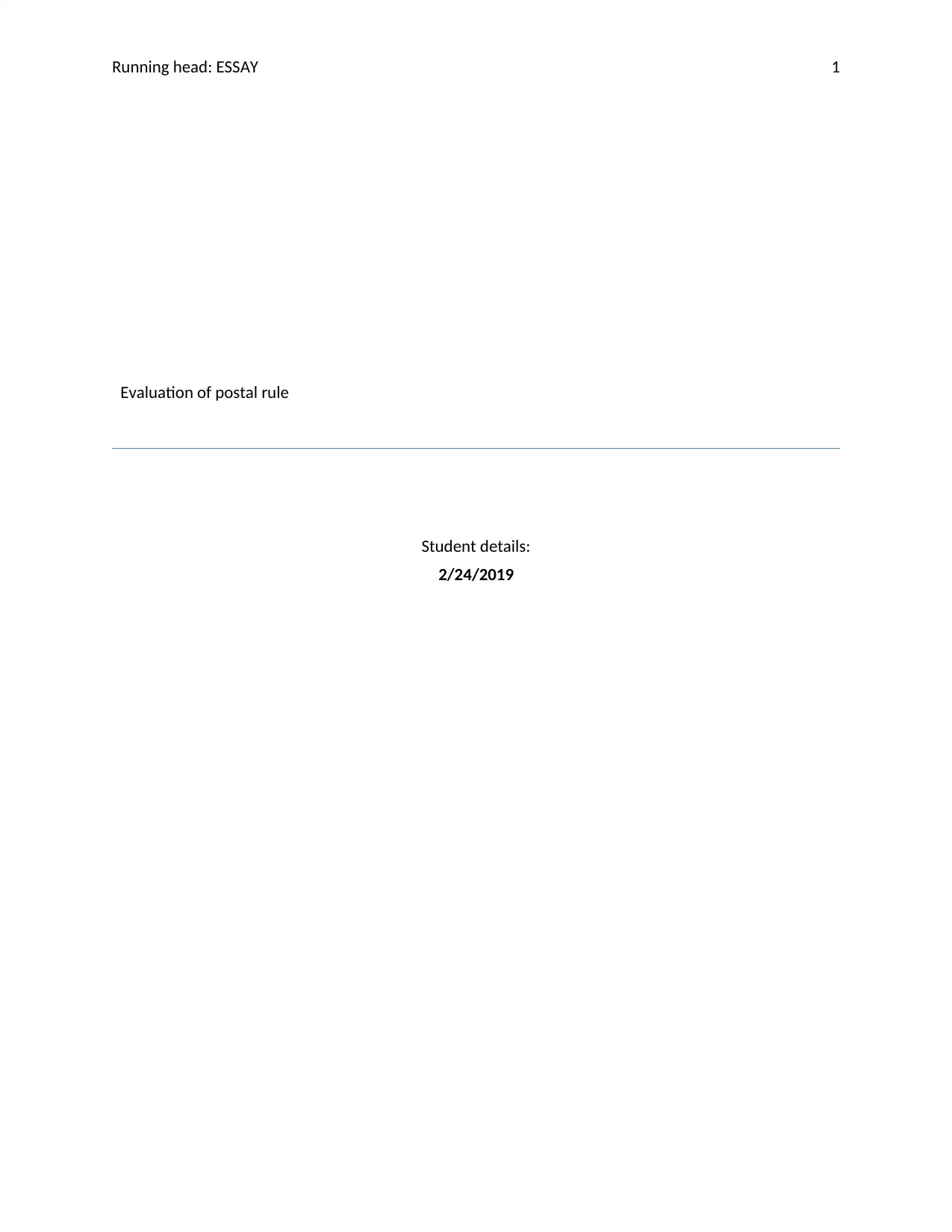
Running head: ESSAY 1
Evaluation of postal rule
Student details:
2/24/2019
Evaluation of postal rule
Student details:
2/24/2019
Paraphrase This Document
Need a fresh take? Get an instant paraphrase of this document with our AI Paraphraser
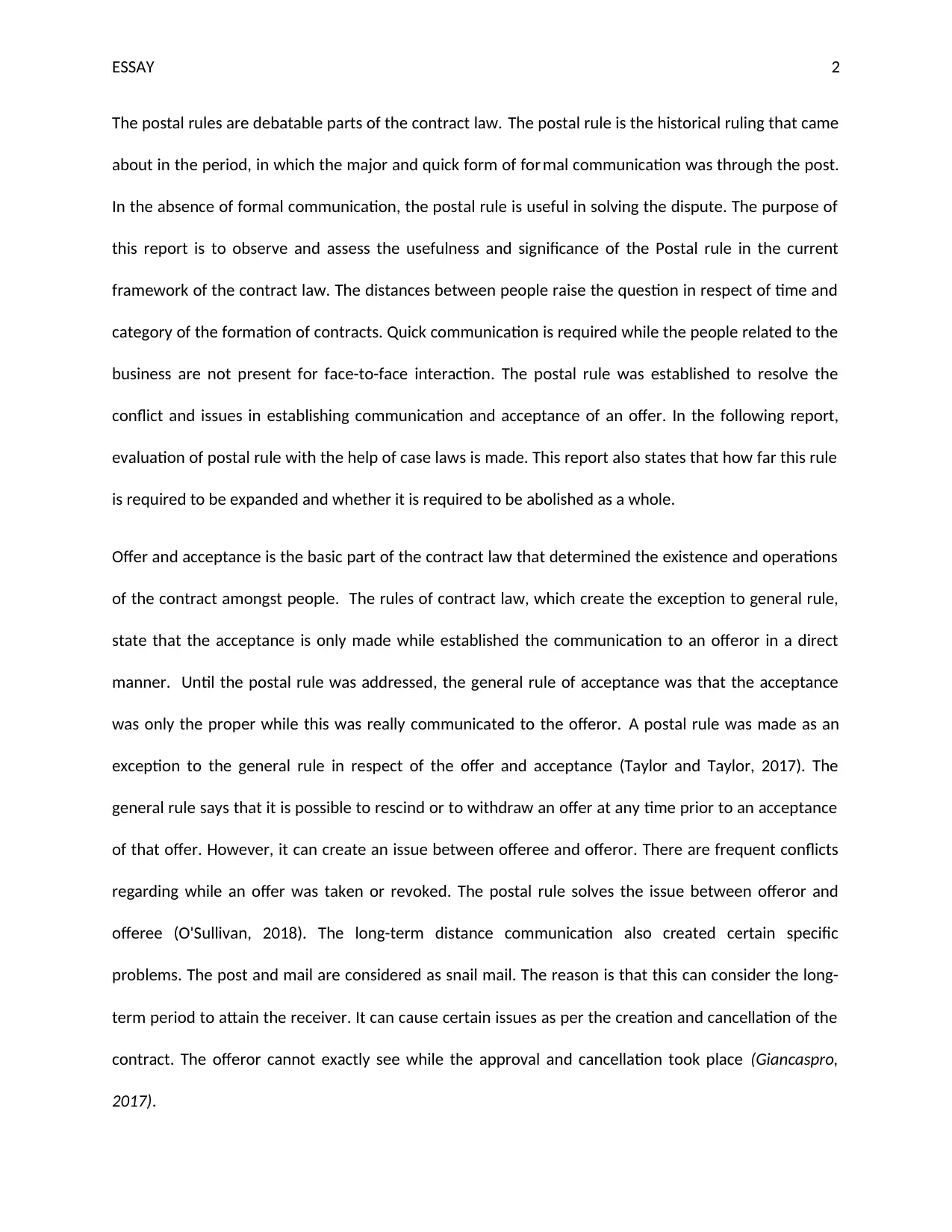
ESSAY 2
The postal rules are debatable parts of the contract law. The postal rule is the historical ruling that came
about in the period, in which the major and quick form of for mal communication was through the post.
In the absence of formal communication, the postal rule is useful in solving the dispute. The purpose of
this report is to observe and assess the usefulness and significance of the Postal rule in the current
framework of the contract law. The distances between people raise the question in respect of time and
category of the formation of contracts. Quick communication is required while the people related to the
business are not present for face-to-face interaction. The postal rule was established to resolve the
conflict and issues in establishing communication and acceptance of an offer. In the following report,
evaluation of postal rule with the help of case laws is made. This report also states that how far this rule
is required to be expanded and whether it is required to be abolished as a whole.
Offer and acceptance is the basic part of the contract law that determined the existence and operations
of the contract amongst people. The rules of contract law, which create the exception to general rule,
state that the acceptance is only made while established the communication to an offeror in a direct
manner. Until the postal rule was addressed, the general rule of acceptance was that the acceptance
was only the proper while this was really communicated to the offeror. A postal rule was made as an
exception to the general rule in respect of the offer and acceptance (Taylor and Taylor, 2017). The
general rule says that it is possible to rescind or to withdraw an offer at any time prior to an acceptance
of that offer. However, it can create an issue between offeree and offeror. There are frequent conflicts
regarding while an offer was taken or revoked. The postal rule solves the issue between offeror and
offeree (O'Sullivan, 2018). The long-term distance communication also created certain specific
problems. The post and mail are considered as snail mail. The reason is that this can consider the long-
term period to attain the receiver. It can cause certain issues as per the creation and cancellation of the
contract. The offeror cannot exactly see while the approval and cancellation took place (Giancaspro,
2017).
The postal rules are debatable parts of the contract law. The postal rule is the historical ruling that came
about in the period, in which the major and quick form of for mal communication was through the post.
In the absence of formal communication, the postal rule is useful in solving the dispute. The purpose of
this report is to observe and assess the usefulness and significance of the Postal rule in the current
framework of the contract law. The distances between people raise the question in respect of time and
category of the formation of contracts. Quick communication is required while the people related to the
business are not present for face-to-face interaction. The postal rule was established to resolve the
conflict and issues in establishing communication and acceptance of an offer. In the following report,
evaluation of postal rule with the help of case laws is made. This report also states that how far this rule
is required to be expanded and whether it is required to be abolished as a whole.
Offer and acceptance is the basic part of the contract law that determined the existence and operations
of the contract amongst people. The rules of contract law, which create the exception to general rule,
state that the acceptance is only made while established the communication to an offeror in a direct
manner. Until the postal rule was addressed, the general rule of acceptance was that the acceptance
was only the proper while this was really communicated to the offeror. A postal rule was made as an
exception to the general rule in respect of the offer and acceptance (Taylor and Taylor, 2017). The
general rule says that it is possible to rescind or to withdraw an offer at any time prior to an acceptance
of that offer. However, it can create an issue between offeree and offeror. There are frequent conflicts
regarding while an offer was taken or revoked. The postal rule solves the issue between offeror and
offeree (O'Sullivan, 2018). The long-term distance communication also created certain specific
problems. The post and mail are considered as snail mail. The reason is that this can consider the long-
term period to attain the receiver. It can cause certain issues as per the creation and cancellation of the
contract. The offeror cannot exactly see while the approval and cancellation took place (Giancaspro,
2017).
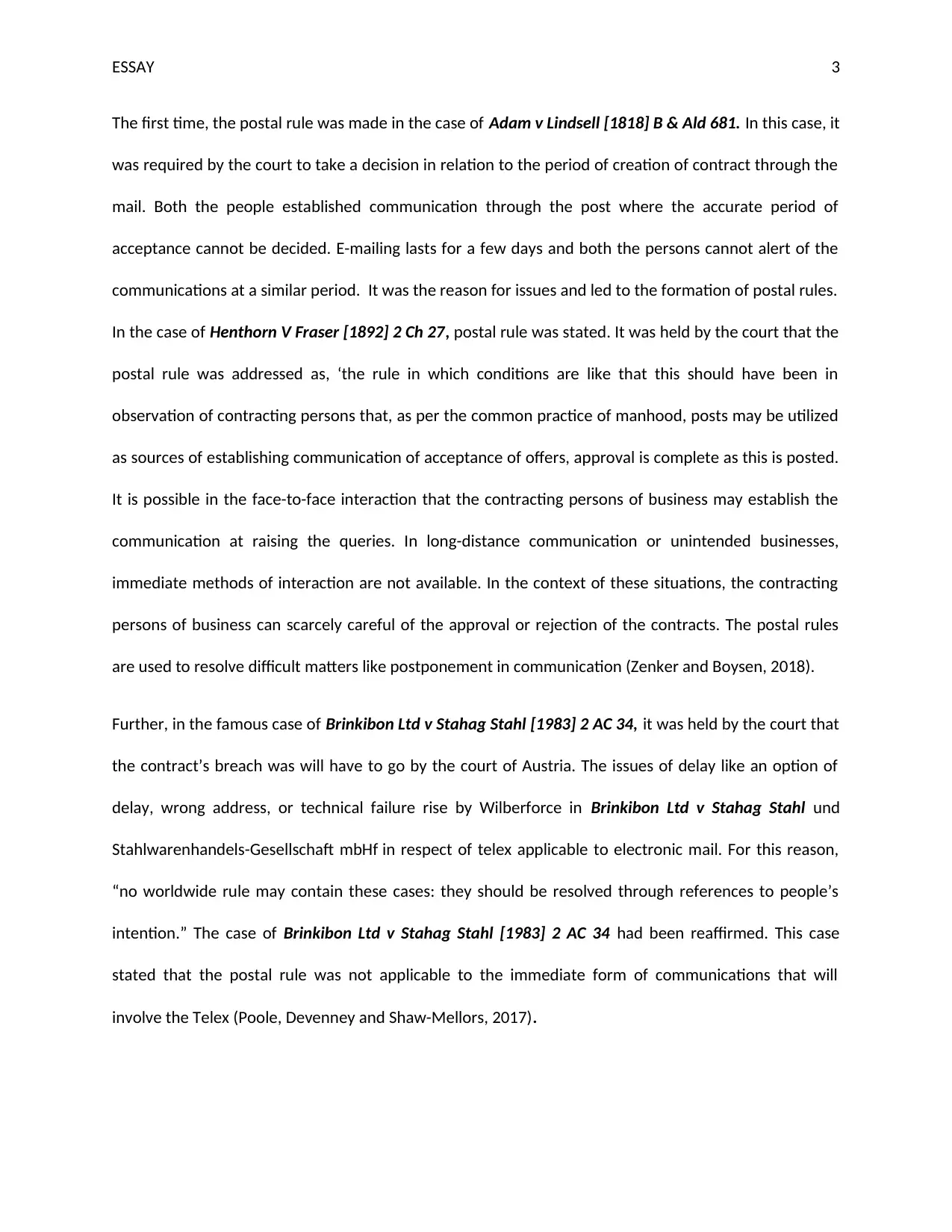
ESSAY 3
The first time, the postal rule was made in the case of Adam v Lindsell [1818] B & Ald 681. In this case, it
was required by the court to take a decision in relation to the period of creation of contract through the
mail. Both the people established communication through the post where the accurate period of
acceptance cannot be decided. E-mailing lasts for a few days and both the persons cannot alert of the
communications at a similar period. It was the reason for issues and led to the formation of postal rules.
In the case of Henthorn V Fraser [1892] 2 Ch 27, postal rule was stated. It was held by the court that the
postal rule was addressed as, ‘the rule in which conditions are like that this should have been in
observation of contracting persons that, as per the common practice of manhood, posts may be utilized
as sources of establishing communication of acceptance of offers, approval is complete as this is posted.
It is possible in the face-to-face interaction that the contracting persons of business may establish the
communication at raising the queries. In long-distance communication or unintended businesses,
immediate methods of interaction are not available. In the context of these situations, the contracting
persons of business can scarcely careful of the approval or rejection of the contracts. The postal rules
are used to resolve difficult matters like postponement in communication (Zenker and Boysen, 2018).
Further, in the famous case of Brinkibon Ltd v Stahag Stahl [1983] 2 AC 34, it was held by the court that
the contract’s breach was will have to go by the court of Austria. The issues of delay like an option of
delay, wrong address, or technical failure rise by Wilberforce in Brinkibon Ltd v Stahag Stahl und
Stahlwarenhandels-Gesellschaft mbHf in respect of telex applicable to electronic mail. For this reason,
“no worldwide rule may contain these cases: they should be resolved through references to people’s
intention.” The case of Brinkibon Ltd v Stahag Stahl [1983] 2 AC 34 had been reaffirmed. This case
stated that the postal rule was not applicable to the immediate form of communications that will
involve the Telex (Poole, Devenney and Shaw-Mellors, 2017).
The first time, the postal rule was made in the case of Adam v Lindsell [1818] B & Ald 681. In this case, it
was required by the court to take a decision in relation to the period of creation of contract through the
mail. Both the people established communication through the post where the accurate period of
acceptance cannot be decided. E-mailing lasts for a few days and both the persons cannot alert of the
communications at a similar period. It was the reason for issues and led to the formation of postal rules.
In the case of Henthorn V Fraser [1892] 2 Ch 27, postal rule was stated. It was held by the court that the
postal rule was addressed as, ‘the rule in which conditions are like that this should have been in
observation of contracting persons that, as per the common practice of manhood, posts may be utilized
as sources of establishing communication of acceptance of offers, approval is complete as this is posted.
It is possible in the face-to-face interaction that the contracting persons of business may establish the
communication at raising the queries. In long-distance communication or unintended businesses,
immediate methods of interaction are not available. In the context of these situations, the contracting
persons of business can scarcely careful of the approval or rejection of the contracts. The postal rules
are used to resolve difficult matters like postponement in communication (Zenker and Boysen, 2018).
Further, in the famous case of Brinkibon Ltd v Stahag Stahl [1983] 2 AC 34, it was held by the court that
the contract’s breach was will have to go by the court of Austria. The issues of delay like an option of
delay, wrong address, or technical failure rise by Wilberforce in Brinkibon Ltd v Stahag Stahl und
Stahlwarenhandels-Gesellschaft mbHf in respect of telex applicable to electronic mail. For this reason,
“no worldwide rule may contain these cases: they should be resolved through references to people’s
intention.” The case of Brinkibon Ltd v Stahag Stahl [1983] 2 AC 34 had been reaffirmed. This case
stated that the postal rule was not applicable to the immediate form of communications that will
involve the Telex (Poole, Devenney and Shaw-Mellors, 2017).
⊘ This is a preview!⊘
Do you want full access?
Subscribe today to unlock all pages.

Trusted by 1+ million students worldwide
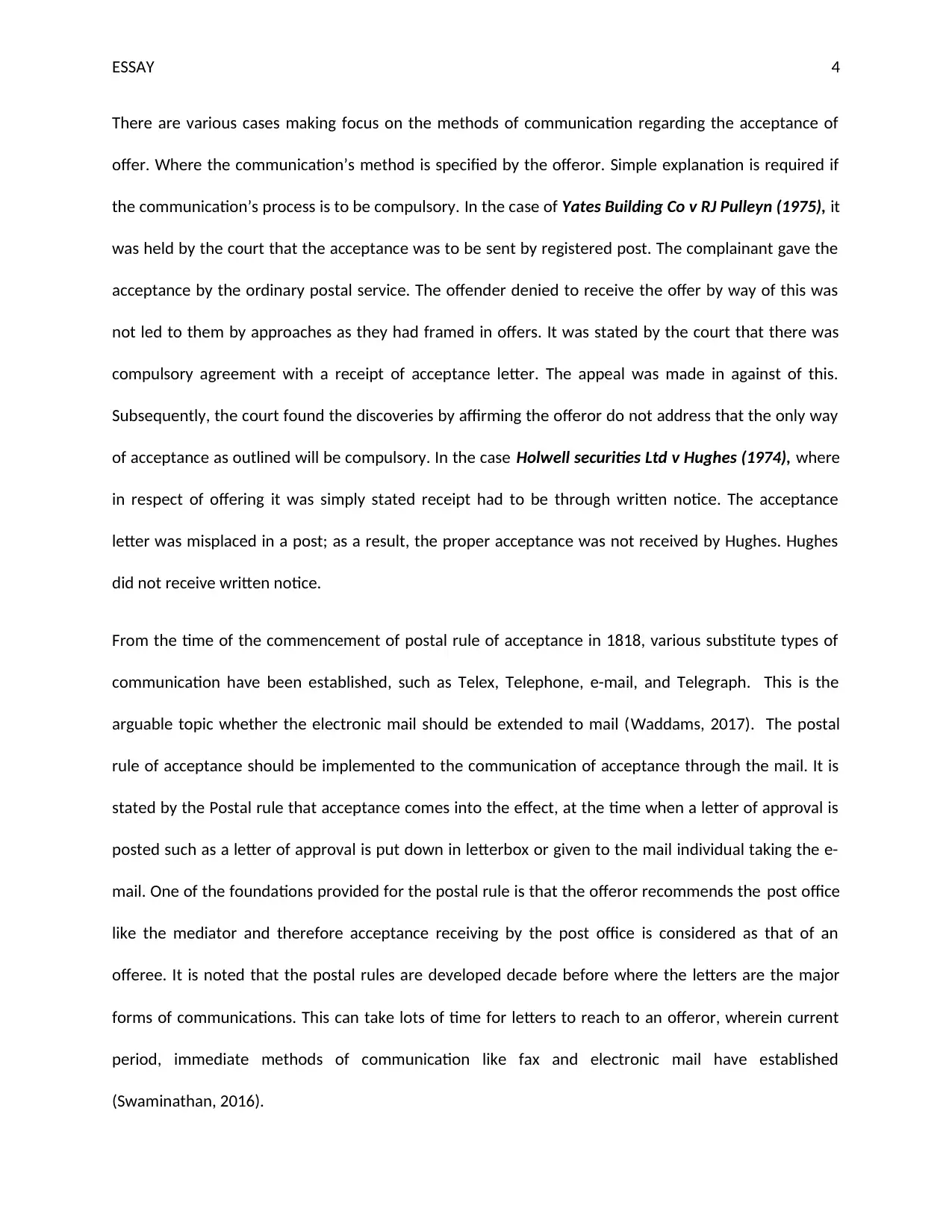
ESSAY 4
There are various cases making focus on the methods of communication regarding the acceptance of
offer. Where the communication’s method is specified by the offeror. Simple explanation is required if
the communication’s process is to be compulsory. In the case of Yates Building Co v RJ Pulleyn (1975), it
was held by the court that the acceptance was to be sent by registered post. The complainant gave the
acceptance by the ordinary postal service. The offender denied to receive the offer by way of this was
not led to them by approaches as they had framed in offers. It was stated by the court that there was
compulsory agreement with a receipt of acceptance letter. The appeal was made in against of this.
Subsequently, the court found the discoveries by affirming the offeror do not address that the only way
of acceptance as outlined will be compulsory. In the case Holwell securities Ltd v Hughes (1974), where
in respect of offering it was simply stated receipt had to be through written notice. The acceptance
letter was misplaced in a post; as a result, the proper acceptance was not received by Hughes. Hughes
did not receive written notice.
From the time of the commencement of postal rule of acceptance in 1818, various substitute types of
communication have been established, such as Telex, Telephone, e-mail, and Telegraph. This is the
arguable topic whether the electronic mail should be extended to mail (Waddams, 2017). The postal
rule of acceptance should be implemented to the communication of acceptance through the mail. It is
stated by the Postal rule that acceptance comes into the effect, at the time when a letter of approval is
posted such as a letter of approval is put down in letterbox or given to the mail individual taking the e-
mail. One of the foundations provided for the postal rule is that the offeror recommends the post office
like the mediator and therefore acceptance receiving by the post office is considered as that of an
offeree. It is noted that the postal rules are developed decade before where the letters are the major
forms of communications. This can take lots of time for letters to reach to an offeror, wherein current
period, immediate methods of communication like fax and electronic mail have established
(Swaminathan, 2016).
There are various cases making focus on the methods of communication regarding the acceptance of
offer. Where the communication’s method is specified by the offeror. Simple explanation is required if
the communication’s process is to be compulsory. In the case of Yates Building Co v RJ Pulleyn (1975), it
was held by the court that the acceptance was to be sent by registered post. The complainant gave the
acceptance by the ordinary postal service. The offender denied to receive the offer by way of this was
not led to them by approaches as they had framed in offers. It was stated by the court that there was
compulsory agreement with a receipt of acceptance letter. The appeal was made in against of this.
Subsequently, the court found the discoveries by affirming the offeror do not address that the only way
of acceptance as outlined will be compulsory. In the case Holwell securities Ltd v Hughes (1974), where
in respect of offering it was simply stated receipt had to be through written notice. The acceptance
letter was misplaced in a post; as a result, the proper acceptance was not received by Hughes. Hughes
did not receive written notice.
From the time of the commencement of postal rule of acceptance in 1818, various substitute types of
communication have been established, such as Telex, Telephone, e-mail, and Telegraph. This is the
arguable topic whether the electronic mail should be extended to mail (Waddams, 2017). The postal
rule of acceptance should be implemented to the communication of acceptance through the mail. It is
stated by the Postal rule that acceptance comes into the effect, at the time when a letter of approval is
posted such as a letter of approval is put down in letterbox or given to the mail individual taking the e-
mail. One of the foundations provided for the postal rule is that the offeror recommends the post office
like the mediator and therefore acceptance receiving by the post office is considered as that of an
offeree. It is noted that the postal rules are developed decade before where the letters are the major
forms of communications. This can take lots of time for letters to reach to an offeror, wherein current
period, immediate methods of communication like fax and electronic mail have established
(Swaminathan, 2016).
Paraphrase This Document
Need a fresh take? Get an instant paraphrase of this document with our AI Paraphraser
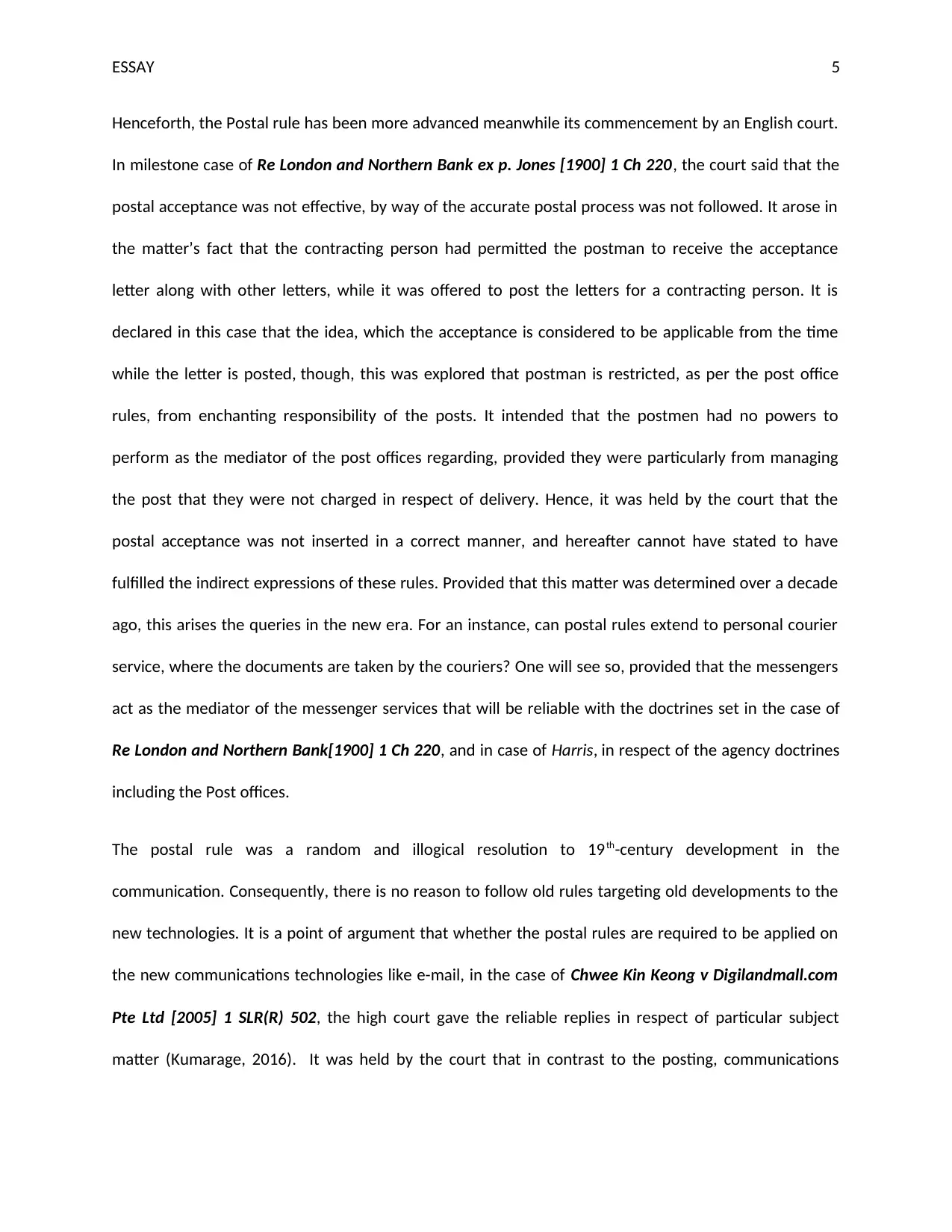
ESSAY 5
Henceforth, the Postal rule has been more advanced meanwhile its commencement by an English court.
In milestone case of Re London and Northern Bank ex p. Jones [1900] 1 Ch 220, the court said that the
postal acceptance was not effective, by way of the accurate postal process was not followed. It arose in
the matter’s fact that the contracting person had permitted the postman to receive the acceptance
letter along with other letters, while it was offered to post the letters for a contracting person. It is
declared in this case that the idea, which the acceptance is considered to be applicable from the time
while the letter is posted, though, this was explored that postman is restricted, as per the post office
rules, from enchanting responsibility of the posts. It intended that the postmen had no powers to
perform as the mediator of the post offices regarding, provided they were particularly from managing
the post that they were not charged in respect of delivery. Hence, it was held by the court that the
postal acceptance was not inserted in a correct manner, and hereafter cannot have stated to have
fulfilled the indirect expressions of these rules. Provided that this matter was determined over a decade
ago, this arises the queries in the new era. For an instance, can postal rules extend to personal courier
service, where the documents are taken by the couriers? One will see so, provided that the messengers
act as the mediator of the messenger services that will be reliable with the doctrines set in the case of
Re London and Northern Bank[1900] 1 Ch 220, and in case of Harris, in respect of the agency doctrines
including the Post offices.
The postal rule was a random and illogical resolution to 19th-century development in the
communication. Consequently, there is no reason to follow old rules targeting old developments to the
new technologies. It is a point of argument that whether the postal rules are required to be applied on
the new communications technologies like e-mail, in the case of Chwee Kin Keong v Digilandmall.com
Pte Ltd [2005] 1 SLR(R) 502, the high court gave the reliable replies in respect of particular subject
matter (Kumarage, 2016). It was held by the court that in contrast to the posting, communications
Henceforth, the Postal rule has been more advanced meanwhile its commencement by an English court.
In milestone case of Re London and Northern Bank ex p. Jones [1900] 1 Ch 220, the court said that the
postal acceptance was not effective, by way of the accurate postal process was not followed. It arose in
the matter’s fact that the contracting person had permitted the postman to receive the acceptance
letter along with other letters, while it was offered to post the letters for a contracting person. It is
declared in this case that the idea, which the acceptance is considered to be applicable from the time
while the letter is posted, though, this was explored that postman is restricted, as per the post office
rules, from enchanting responsibility of the posts. It intended that the postmen had no powers to
perform as the mediator of the post offices regarding, provided they were particularly from managing
the post that they were not charged in respect of delivery. Hence, it was held by the court that the
postal acceptance was not inserted in a correct manner, and hereafter cannot have stated to have
fulfilled the indirect expressions of these rules. Provided that this matter was determined over a decade
ago, this arises the queries in the new era. For an instance, can postal rules extend to personal courier
service, where the documents are taken by the couriers? One will see so, provided that the messengers
act as the mediator of the messenger services that will be reliable with the doctrines set in the case of
Re London and Northern Bank[1900] 1 Ch 220, and in case of Harris, in respect of the agency doctrines
including the Post offices.
The postal rule was a random and illogical resolution to 19th-century development in the
communication. Consequently, there is no reason to follow old rules targeting old developments to the
new technologies. It is a point of argument that whether the postal rules are required to be applied on
the new communications technologies like e-mail, in the case of Chwee Kin Keong v Digilandmall.com
Pte Ltd [2005] 1 SLR(R) 502, the high court gave the reliable replies in respect of particular subject
matter (Kumarage, 2016). It was held by the court that in contrast to the posting, communications
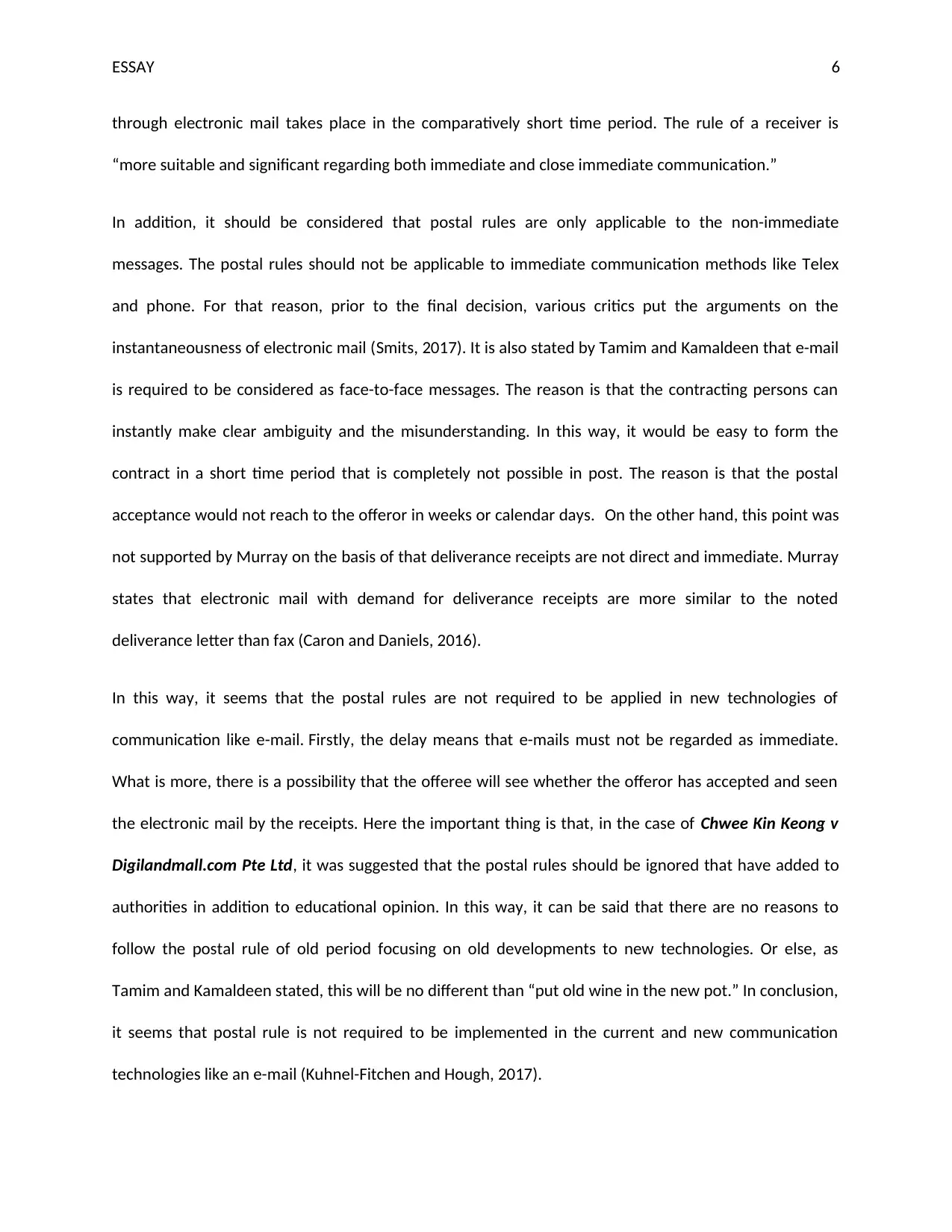
ESSAY 6
through electronic mail takes place in the comparatively short time period. The rule of a receiver is
“more suitable and significant regarding both immediate and close immediate communication.”
In addition, it should be considered that postal rules are only applicable to the non-immediate
messages. The postal rules should not be applicable to immediate communication methods like Telex
and phone. For that reason, prior to the final decision, various critics put the arguments on the
instantaneousness of electronic mail (Smits, 2017). It is also stated by Tamim and Kamaldeen that e-mail
is required to be considered as face-to-face messages. The reason is that the contracting persons can
instantly make clear ambiguity and the misunderstanding. In this way, it would be easy to form the
contract in a short time period that is completely not possible in post. The reason is that the postal
acceptance would not reach to the offeror in weeks or calendar days. On the other hand, this point was
not supported by Murray on the basis of that deliverance receipts are not direct and immediate. Murray
states that electronic mail with demand for deliverance receipts are more similar to the noted
deliverance letter than fax (Caron and Daniels, 2016).
In this way, it seems that the postal rules are not required to be applied in new technologies of
communication like e-mail. Firstly, the delay means that e-mails must not be regarded as immediate.
What is more, there is a possibility that the offeree will see whether the offeror has accepted and seen
the electronic mail by the receipts. Here the important thing is that, in the case of Chwee Kin Keong v
Digilandmall.com Pte Ltd, it was suggested that the postal rules should be ignored that have added to
authorities in addition to educational opinion. In this way, it can be said that there are no reasons to
follow the postal rule of old period focusing on old developments to new technologies. Or else, as
Tamim and Kamaldeen stated, this will be no different than “put old wine in the new pot.” In conclusion,
it seems that postal rule is not required to be implemented in the current and new communication
technologies like an e-mail (Kuhnel-Fitchen and Hough, 2017).
through electronic mail takes place in the comparatively short time period. The rule of a receiver is
“more suitable and significant regarding both immediate and close immediate communication.”
In addition, it should be considered that postal rules are only applicable to the non-immediate
messages. The postal rules should not be applicable to immediate communication methods like Telex
and phone. For that reason, prior to the final decision, various critics put the arguments on the
instantaneousness of electronic mail (Smits, 2017). It is also stated by Tamim and Kamaldeen that e-mail
is required to be considered as face-to-face messages. The reason is that the contracting persons can
instantly make clear ambiguity and the misunderstanding. In this way, it would be easy to form the
contract in a short time period that is completely not possible in post. The reason is that the postal
acceptance would not reach to the offeror in weeks or calendar days. On the other hand, this point was
not supported by Murray on the basis of that deliverance receipts are not direct and immediate. Murray
states that electronic mail with demand for deliverance receipts are more similar to the noted
deliverance letter than fax (Caron and Daniels, 2016).
In this way, it seems that the postal rules are not required to be applied in new technologies of
communication like e-mail. Firstly, the delay means that e-mails must not be regarded as immediate.
What is more, there is a possibility that the offeree will see whether the offeror has accepted and seen
the electronic mail by the receipts. Here the important thing is that, in the case of Chwee Kin Keong v
Digilandmall.com Pte Ltd, it was suggested that the postal rules should be ignored that have added to
authorities in addition to educational opinion. In this way, it can be said that there are no reasons to
follow the postal rule of old period focusing on old developments to new technologies. Or else, as
Tamim and Kamaldeen stated, this will be no different than “put old wine in the new pot.” In conclusion,
it seems that postal rule is not required to be implemented in the current and new communication
technologies like an e-mail (Kuhnel-Fitchen and Hough, 2017).
⊘ This is a preview!⊘
Do you want full access?
Subscribe today to unlock all pages.

Trusted by 1+ million students worldwide
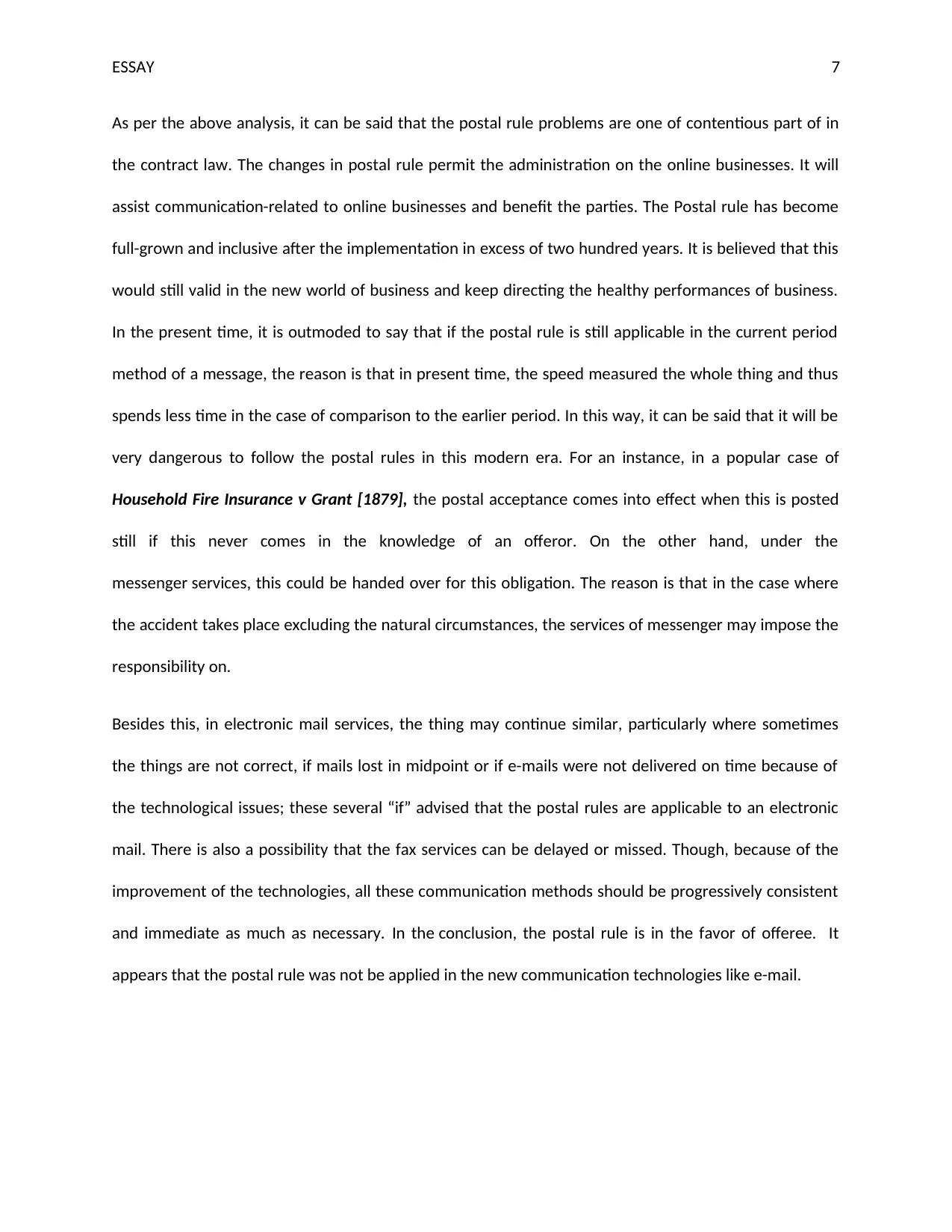
ESSAY 7
As per the above analysis, it can be said that the postal rule problems are one of contentious part of in
the contract law. The changes in postal rule permit the administration on the online businesses. It will
assist communication-related to online businesses and benefit the parties. The Postal rule has become
full-grown and inclusive after the implementation in excess of two hundred years. It is believed that this
would still valid in the new world of business and keep directing the healthy performances of business.
In the present time, it is outmoded to say that if the postal rule is still applicable in the current period
method of a message, the reason is that in present time, the speed measured the whole thing and thus
spends less time in the case of comparison to the earlier period. In this way, it can be said that it will be
very dangerous to follow the postal rules in this modern era. For an instance, in a popular case of
Household Fire Insurance v Grant [1879], the postal acceptance comes into effect when this is posted
still if this never comes in the knowledge of an offeror. On the other hand, under the
messenger services, this could be handed over for this obligation. The reason is that in the case where
the accident takes place excluding the natural circumstances, the services of messenger may impose the
responsibility on.
Besides this, in electronic mail services, the thing may continue similar, particularly where sometimes
the things are not correct, if mails lost in midpoint or if e-mails were not delivered on time because of
the technological issues; these several “if” advised that the postal rules are applicable to an electronic
mail. There is also a possibility that the fax services can be delayed or missed. Though, because of the
improvement of the technologies, all these communication methods should be progressively consistent
and immediate as much as necessary. In the conclusion, the postal rule is in the favor of offeree. It
appears that the postal rule was not be applied in the new communication technologies like e-mail.
As per the above analysis, it can be said that the postal rule problems are one of contentious part of in
the contract law. The changes in postal rule permit the administration on the online businesses. It will
assist communication-related to online businesses and benefit the parties. The Postal rule has become
full-grown and inclusive after the implementation in excess of two hundred years. It is believed that this
would still valid in the new world of business and keep directing the healthy performances of business.
In the present time, it is outmoded to say that if the postal rule is still applicable in the current period
method of a message, the reason is that in present time, the speed measured the whole thing and thus
spends less time in the case of comparison to the earlier period. In this way, it can be said that it will be
very dangerous to follow the postal rules in this modern era. For an instance, in a popular case of
Household Fire Insurance v Grant [1879], the postal acceptance comes into effect when this is posted
still if this never comes in the knowledge of an offeror. On the other hand, under the
messenger services, this could be handed over for this obligation. The reason is that in the case where
the accident takes place excluding the natural circumstances, the services of messenger may impose the
responsibility on.
Besides this, in electronic mail services, the thing may continue similar, particularly where sometimes
the things are not correct, if mails lost in midpoint or if e-mails were not delivered on time because of
the technological issues; these several “if” advised that the postal rules are applicable to an electronic
mail. There is also a possibility that the fax services can be delayed or missed. Though, because of the
improvement of the technologies, all these communication methods should be progressively consistent
and immediate as much as necessary. In the conclusion, the postal rule is in the favor of offeree. It
appears that the postal rule was not be applied in the new communication technologies like e-mail.
Paraphrase This Document
Need a fresh take? Get an instant paraphrase of this document with our AI Paraphraser
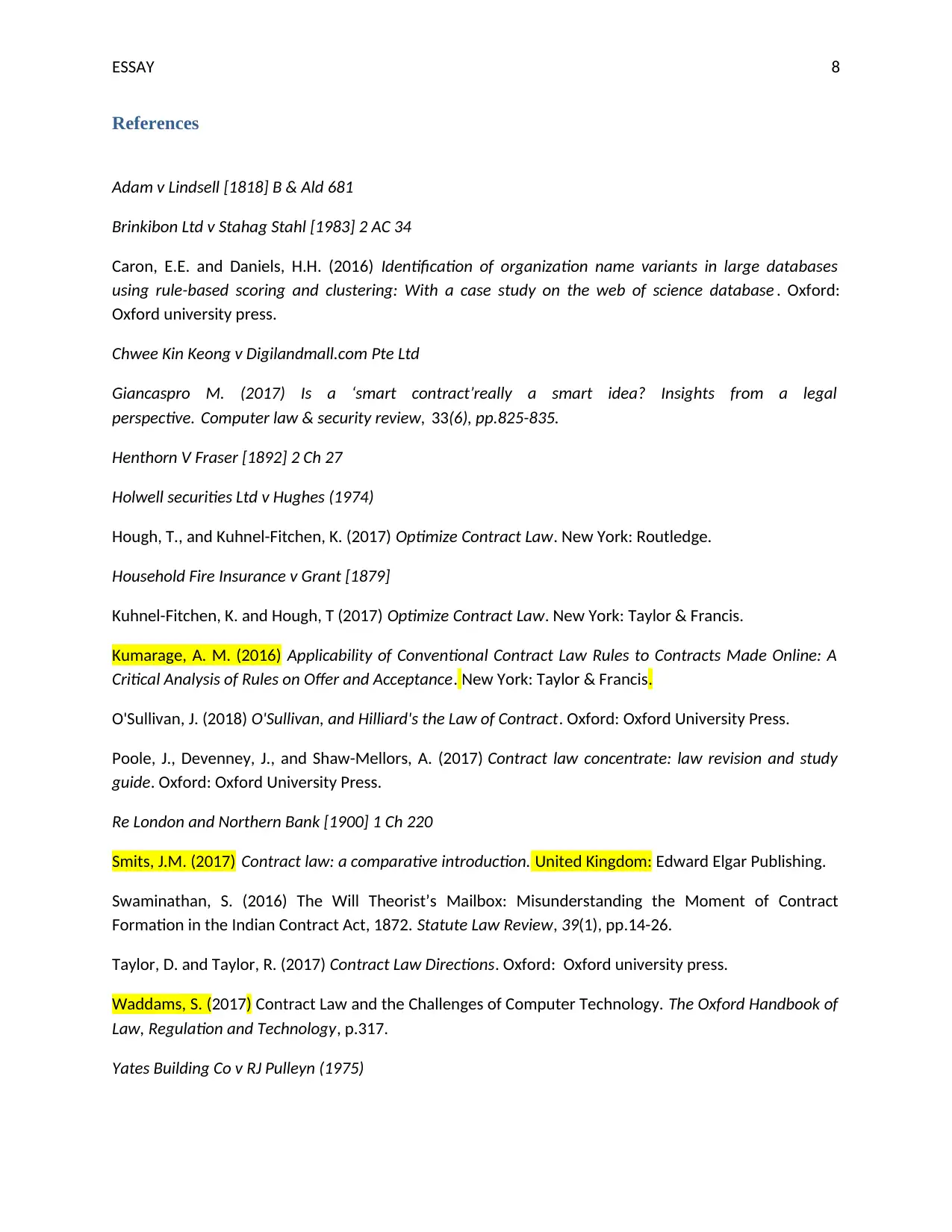
ESSAY 8
References
Adam v Lindsell [1818] B & Ald 681
Brinkibon Ltd v Stahag Stahl [1983] 2 AC 34
Caron, E.E. and Daniels, H.H. (2016) Identification of organization name variants in large databases
using rule-based scoring and clustering: With a case study on the web of science database . Oxford:
Oxford university press.
Chwee Kin Keong v Digilandmall.com Pte Ltd
Giancaspro M. (2017) Is a ‘smart contract’really a smart idea? Insights from a legal
perspective. Computer law & security review, 33(6), pp.825-835.
Henthorn V Fraser [1892] 2 Ch 27
Holwell securities Ltd v Hughes (1974)
Hough, T., and Kuhnel-Fitchen, K. (2017) Optimize Contract Law. New York: Routledge.
Household Fire Insurance v Grant [1879]
Kuhnel-Fitchen, K. and Hough, T (2017) Optimize Contract Law. New York: Taylor & Francis.
Kumarage, A. M. (2016) Applicability of Conventional Contract Law Rules to Contracts Made Online: A
Critical Analysis of Rules on Offer and Acceptance. New York: Taylor & Francis.
O'Sullivan, J. (2018) O'Sullivan, and Hilliard's the Law of Contract. Oxford: Oxford University Press.
Poole, J., Devenney, J., and Shaw-Mellors, A. (2017) Contract law concentrate: law revision and study
guide. Oxford: Oxford University Press.
Re London and Northern Bank [1900] 1 Ch 220
Smits, J.M. (2017) Contract law: a comparative introduction. United Kingdom: Edward Elgar Publishing.
Swaminathan, S. (2016) The Will Theorist’s Mailbox: Misunderstanding the Moment of Contract
Formation in the Indian Contract Act, 1872. Statute Law Review, 39(1), pp.14-26.
Taylor, D. and Taylor, R. (2017) Contract Law Directions. Oxford: Oxford university press.
Waddams, S. (2017) Contract Law and the Challenges of Computer Technology. The Oxford Handbook of
Law, Regulation and Technology, p.317.
Yates Building Co v RJ Pulleyn (1975)
References
Adam v Lindsell [1818] B & Ald 681
Brinkibon Ltd v Stahag Stahl [1983] 2 AC 34
Caron, E.E. and Daniels, H.H. (2016) Identification of organization name variants in large databases
using rule-based scoring and clustering: With a case study on the web of science database . Oxford:
Oxford university press.
Chwee Kin Keong v Digilandmall.com Pte Ltd
Giancaspro M. (2017) Is a ‘smart contract’really a smart idea? Insights from a legal
perspective. Computer law & security review, 33(6), pp.825-835.
Henthorn V Fraser [1892] 2 Ch 27
Holwell securities Ltd v Hughes (1974)
Hough, T., and Kuhnel-Fitchen, K. (2017) Optimize Contract Law. New York: Routledge.
Household Fire Insurance v Grant [1879]
Kuhnel-Fitchen, K. and Hough, T (2017) Optimize Contract Law. New York: Taylor & Francis.
Kumarage, A. M. (2016) Applicability of Conventional Contract Law Rules to Contracts Made Online: A
Critical Analysis of Rules on Offer and Acceptance. New York: Taylor & Francis.
O'Sullivan, J. (2018) O'Sullivan, and Hilliard's the Law of Contract. Oxford: Oxford University Press.
Poole, J., Devenney, J., and Shaw-Mellors, A. (2017) Contract law concentrate: law revision and study
guide. Oxford: Oxford University Press.
Re London and Northern Bank [1900] 1 Ch 220
Smits, J.M. (2017) Contract law: a comparative introduction. United Kingdom: Edward Elgar Publishing.
Swaminathan, S. (2016) The Will Theorist’s Mailbox: Misunderstanding the Moment of Contract
Formation in the Indian Contract Act, 1872. Statute Law Review, 39(1), pp.14-26.
Taylor, D. and Taylor, R. (2017) Contract Law Directions. Oxford: Oxford university press.
Waddams, S. (2017) Contract Law and the Challenges of Computer Technology. The Oxford Handbook of
Law, Regulation and Technology, p.317.
Yates Building Co v RJ Pulleyn (1975)

ESSAY 9
Zenker, M. and Boysen, N. (2018) Dock sharing in cross-docking facilities of the postal service industry.
Journal of the Operational Research Society, 69(7), pp. 1061-1076.
Zenker, M. and Boysen, N. (2018) Dock sharing in cross-docking facilities of the postal service industry.
Journal of the Operational Research Society, 69(7), pp. 1061-1076.
⊘ This is a preview!⊘
Do you want full access?
Subscribe today to unlock all pages.

Trusted by 1+ million students worldwide
1 out of 9
Related Documents
Your All-in-One AI-Powered Toolkit for Academic Success.
+13062052269
info@desklib.com
Available 24*7 on WhatsApp / Email
![[object Object]](/_next/static/media/star-bottom.7253800d.svg)
Unlock your academic potential
Copyright © 2020–2025 A2Z Services. All Rights Reserved. Developed and managed by ZUCOL.




